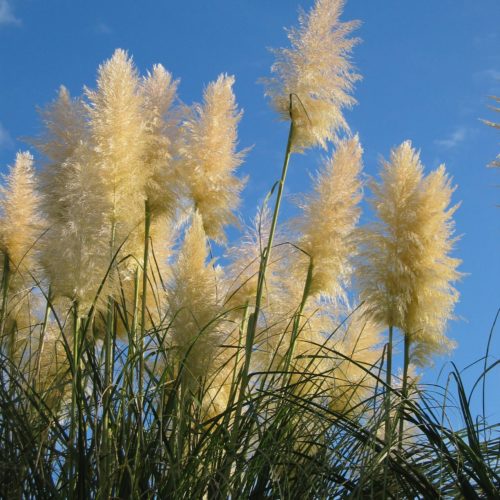Jubata Grass
Cortaderia jubata

Family: Poaceae
Other Common Names: purple pampas grass, Andean pampas grass, pampas grass, pink pampas grass
Weed class: C
Year Listed: 2015
Native to: Bolivia, Ecuador, Peru, Chile and Argentina
Is this Weed Toxic?:
not known to be
Why Is It a Noxious Weed?
Jubata grass looks very similar to pampas grass, which is the showier of the two species and is more often planted in landscapes. Jubata grass is occasionally used as an ornamental and is listed as a noxious weed in California and Oregon. Large infestations occur along the coast in California and parts of Oregon and is documented in Washington. In 2014, escaped populations of pampas grass were discovered in Washington. Due to the similarity in appearance of jubata and pampas grass, and that jubata grass is a listed noxious weed in nearby states, it is also listed as a noxious weed in Washington.
How would I identify it?
General Description
It is a large perennial grass that grows in basal clumps of long narrow leaves. Flowering stems grow upward, generally at least twice as long as the tussock. Plumes of flowers bloom at stem tips and range in color from deep violet to pinkish to creamy white. All flowers are female and can form seed without pollination.
Flower Description
Its inflorescence is a dense panicle, commonly referred to as a plume or plume-like, and occurs at stem tips. Inflorescences range in length from 1 to 3 feet, are deep violet when immature and then pinkish turning creamy white or tan at maturity. All florets are female.
Leaf description
Leaves are long and narrow, generally up to 6.6 ft long by 0.8 to 1.2 inches wide. Upper and lower blade surfaces are typically hairless, though occasionally have hairs near the collar on the upper surface. Leaf margins are scabrous and sharp--easily cutting skin. Leaf sheaths are densely hairy.
Stem description
Stems, called culms, are stiff and grow 6 to 13 feet tall. Stems are 4 to 7 times as long as the panicles.
Fruit Seed Description
The fruit is a caryopsis (a dry, one-seeded fruit), to 2.5 mm in size. Seed counts on jubata grass plumes found a range of 34,000 to 122,000 seeds produced per inflorescence.
May Be Confused With
Class C noxious weed pampas grass, Cortaderia selloana, is very similar in appearance to jubata grass. Ravenna grass, Saccharum ravennae, a Class B noxious weed, is also similar to jubata grass.
Where does it grow?
It is commonly found along the California coast, growing in areas with a strong marine influence that provides cool, wet winters with little frost and moderate summer temperatures (Drewitz and DiTomaso 2004). It grows in a variety of habitats including disturbed open areas such as roadside cuts, ditch banks, forest clearcuts, mudslides or burned areas. Please click here to see a county level distribution map for jubata grass in Washington.
How Does it Reproduce?
Reproduction is by asexual means only. Although all plants produce only female flowers, viable seeds develop from unfertilized flowers, so pollination isn’t necessary. Seeds are very small and are thought to not last long in the soil seedbank.
How Do I Control It?
General Information
When working with jubata grass, it is important to protect yourself when handling the plants. Leaf edges of jubata grass are very sharp, so make sure to wear leather gloves and protective clothing. Seed germination appears to be positively affected by soil disturbance so any control method that disturbs the soil could encourage seed germination. Plant or seed bare ground with native or non-invasive, non-native plants to provide competition. Instead of planting jubata grass in ornamental plantings, use non-invasive alternatives, such as Calamagrostis acutiflora ‘Karl Foerster’ or Stipa gigantean, giant needle grass.
Manual/Mechanical Control
Cut and bag inflorescences prior to mechanical control to prevent spreading seed. Pulling or hand-grubbing seedlings can provide effective control. For larger plants, a Pulaski, mattock or shovel are the safest and most effective tools for removing established clumps. The entire crown and top section of the roots will need to be removed to prevent resprouting.
Cultural Control
Soil disturbance that creates bare ground can promote invasion, so it is important to minimize disturbance or provide competition to seedlings. Apply mulch to exposed bare ground to smother seeds and prevent germination. Also, planting or seeding desirable, non-invasive plants can provide competition to reduce germination and seedling establishment.
Biological Control
There are no approved biological control agents for pampas grass.
Herbicide Control
Please refer to the PNW Weed Management Handbook, or contact your county noxious weed coordinator.
For More Information
Additional pictures of Jubata grass, Cortaderia jubata
See our Written Findings for jubata grass Cortaderia jubata



